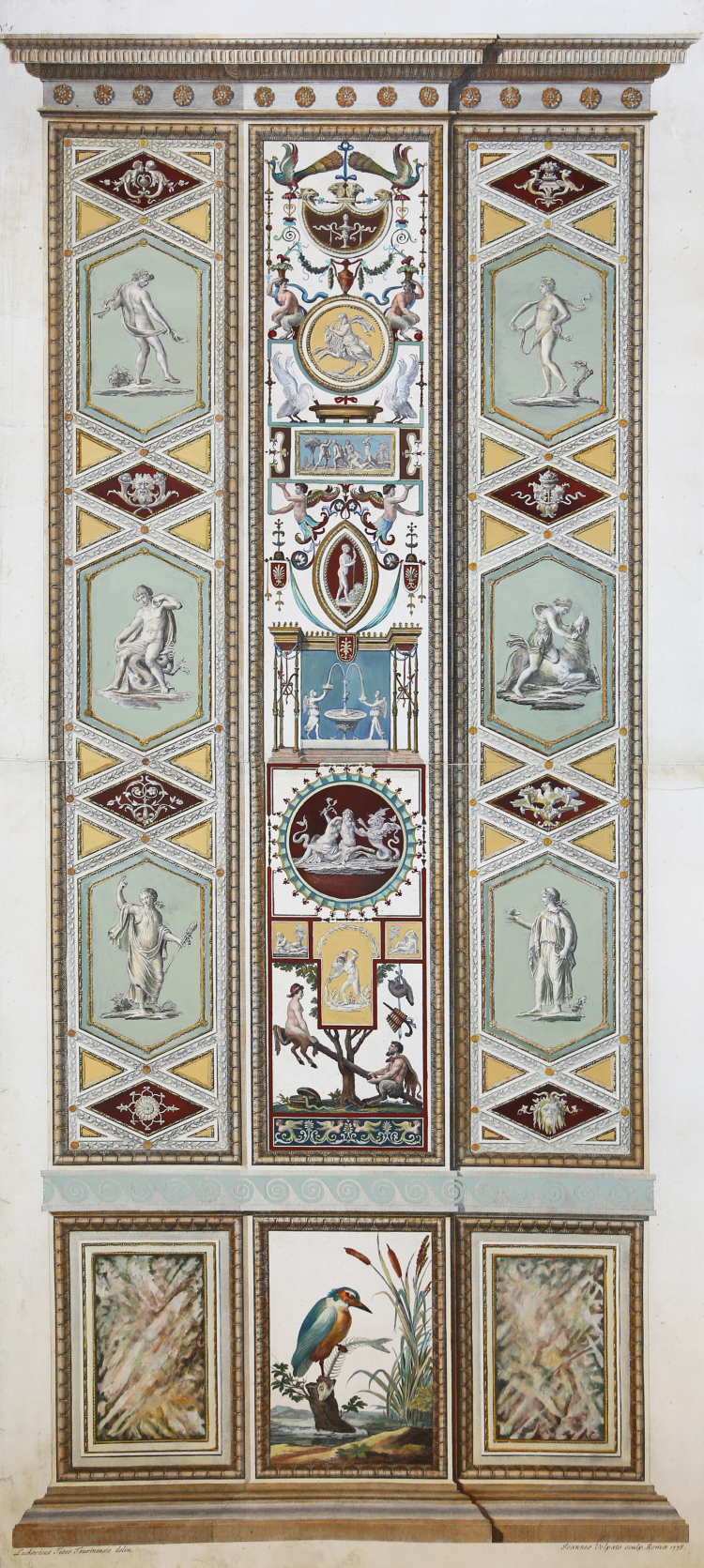



| Reference: | S44008 |
| Author | Giovanni VOLPATO |
| Year: | 1775 |
| Measures: | 480 x 1060 mm |


| Reference: | S44008 |
| Author | Giovanni VOLPATO |
| Year: | 1775 |
| Measures: | 480 x 1060 mm |
Etching and engraving, 1775, signed and dated in plate at lower right.
Beautiful proof, impressed on contemporary laid paper, trimmed to copperplate or with thin margins, in good condition.
Finely hand-colored example with tempera and watercolour.
The series of the Ornati delle Logge di Raffaello nel Vaticano, i.e., the complete printed reproduction of the paintings of the pillars of the Vatican Loggias conceived and frescoed by Raphael, comprising forty-six plates, was produced in its entirety between 1760 and 1777 by engravers Giovanni Ottaviani and Giovanni Volpato. It knew a long and troubled work, justified by the enormous amount of work. The engravings came out, for the first part, in three volumes, between 1768-69 and 1772, the result of the collaboration between the drawings of painter Gaetano Savorelli and those of architect Pietro Camporesi, and the carving work of Giovanni Ottaviani. An inscription appears at the bottom of the plates, bearing the name of the engraver, the two draughtsmen and the papal privilege of Clement XIII. From 1772 - 1774, draughtsman Ludovico Teseo and engraver Giovanni Volpato were added to the monumental work.
The series, to which Volpato owes much of his notoriety, is the first work to address, in detail and comprehensively, the reproduction of the ornamentation of the pillars of the Loggias frescoed by Raphael. The intervention of Volpato, who assumed in a sense the direction of the work by linking his name to the enterprise, constitutes the reason for his move to Rome, probably called by Pope Clement XIV (1769-1774). Volpato's plates, engraved between 1774 and 1776 with the collaboration of Teseo, who was in charge of the reliefs, reproduce the twelve counterpillars of the Loggia with great freedom of translation. The poor visibility of the lower part of the fresco prompted the artist to apply fancy additions, as in the case of some pillars where decorative elements taken from the borders of some Vatican tapestries are inserted.
The collection had a vast resonance and represented one of the most challenging reproduction operations, coming to constitute an important figurative repertoire from which to draw motifs for decoration and contributing to the great success of the grotesque themes of the neoclassical period, influenced by the important discoveries unearthed from the excavations of Pompeii and Herculaneum. Raphael's decoration for the covered gallery leading to the Pope's Palace was immediately perceived as an example of old-fashioned decoration, and it was so successful that art lovers commissioned faithful drawings of Raphael's paintings.
Bibliografia
Giorgio Marini, Volpato, pp. 187/198; Pezzini in "Raphael Invenit" pp. 105/6, 36/45.
Giovanni VOLPATO (Angarano di Bassano, 1740 - Roma, 1803)
|
Italian engraver. In 1760 he entered the famous copperplate printworks of Giambattista Remondini in Bassano and, under the guidance of Antonio Baratti, learnt the art of engraving and etching. During this early period he engraved, signing himself Jean Renard, four Rustic Capricci after Giovanni Battista Piazzetta, the Four Parts of the World after Jacopo Amigoni, the Four Ages of Man after Andrea Zucchi and the portrait of Giambattista Morgagni. On the invitation of Francesco Bartolozzi, who had noted his talent during a visit to Bassano, he moved to Venice in 1762 and was thus able to refine his technique while maintaining his connection with the Remondini concern as a technical consultant and commercial adviser.
|
Giovanni VOLPATO (Angarano di Bassano, 1740 - Roma, 1803)
|
Italian engraver. In 1760 he entered the famous copperplate printworks of Giambattista Remondini in Bassano and, under the guidance of Antonio Baratti, learnt the art of engraving and etching. During this early period he engraved, signing himself Jean Renard, four Rustic Capricci after Giovanni Battista Piazzetta, the Four Parts of the World after Jacopo Amigoni, the Four Ages of Man after Andrea Zucchi and the portrait of Giambattista Morgagni. On the invitation of Francesco Bartolozzi, who had noted his talent during a visit to Bassano, he moved to Venice in 1762 and was thus able to refine his technique while maintaining his connection with the Remondini concern as a technical consultant and commercial adviser.
|